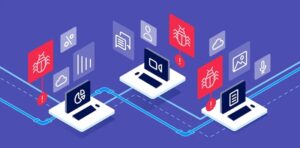As a developer, you’ve certainly heard a lot about new technologies that promise to improve the speed with which you can produce software as well as the robustness of your apps once they’ve been deployed. You are undoubtedly aware that cloud computing technology holds immense promise for developers. This article explores multi-access edge computing, and deployment in cloud computing, and offers guidance that can assist you with real-world application deployments on top of cloud infrastructure.

Why is cloud simplification critical?
If the cloud infrastructure is sophisticated, you will incur more costs. This is why you should collaborate closely with cloud computing consulting businesses to simplify architecture to the greatest extent feasible (Asmus, Fattah and Pavlovski, 2016). When you examine the reasons deployment in cloud computing is becoming more difficult, you will see that one of the most significant factors is the number of platforms and service providers accessible.
Role of Multi-access Edge Computing in application deployment in cloud computing
Multi-access Edge Computing provides cloud computing capabilities and an IT service environment at the network’s edge to application developers and content suppliers. This environment is distinguished by ultra-low latency and high bandwidth, as well as real-time access to radio network information that programs may use. Multi-access Edge Computing creates an entirely new ecosystem and value chain. Operators can expose their Radio Access Network (RAN) edge to approved third parties, allowing them to offer new apps and services to mobile users, corporations, and vertical sectors in a flexible and timely manner (Cruz, Achir and Viana, 2022).
Choose between IaaS, PaaS, or SaaS.
When people talk about cloud computing technology, they usually mean one of three possible deployment options for application code: infrastructure as a service (IaaS), platform as a service (PaaS), or software as a service (SaaS) (SaaS). Which one is best for your project depends on your demands for the code base that you are working on. As an application developer, you should choose PaaS since it manages the infrastructure for you, allowing you to focus on your application code.
Scale your application.
As previously said, PaaS supports scalability out of the box for the majority of languages and runtimes in application deployments. However, as a developer, you must be aware of the many forms of scaling available and when it is appropriate to scale horizontally or vertically. The types of scaling are Vertical scaling, Horizontal scaling. Manual scaling, and automatic scaling (Eivy and Weinman, 2017). As a developer, you should select a platform that supports both manual and automated horizontal scaling.
Consider the application’s state.
Most cloud providers that provide PaaS want you to start with greenfield development, which is projects that are not constrained by previous work. Porting current or legacy deployment in cloud computing might be difficult because the file systems in situ are ephemeral and do not allow for the preservation of application information or resources on the file system.
You should create stateless apps for greenfield applications, which do not save user resources or assets on the system files. Choose a PaaS provider that enables both stateful and stateless apps for legacy or current applications.

Select a database for cloud-based apps.
If your application deployments code does not need to link to an existing corporate database, your possibilities are nearly limitless. We recommend that you put your database in the same geography/data center/region as your application code but on distinct containers or servers. This option is useful for scaling the database independently of the web layer. Also, regardless of whether it’s a SQL or NoSQL database, select one that scales rapidly and easily (Noghabi, Kolb, Bodik and Cuervo, 2018).
Consider various geographies.
Choose a cloud computing technology service provider that allows you to build and grow your application infrastructure across many locales across the world to guarantee your audience has a quick and responsive experience while using your application.
REST-based web services may be created and used.
As you can see, putting your application code in the cloud has several advantages, one of which is the flexibility to scale out the web and database tiers independently. Separating your application logic from the display tier gives you possibilities for technologies you may not have explored previously.
Put in place continuous delivery and integration.
Choose a cloud computing technology service provider that fits all of the above criteria while also providing integrated continuous integration and continuous delivery (CI/CD) capabilities on the platform (Garg and Garg, 2019). The service you select should allow you to establish your build system or simply interact with current systems that are not hosted on the cloud platform.
Prevent vendor lock-in
Many cloud providers provide attractive proprietary APIs for application deployments that decrease the amount of code or labour you have to perform, you should avoid them at all costs.

References
Asmus, S., Fattah, A. and Pavlovski, C. (2016). Enterprise Cloud Deployment: Integration Patterns and Assessment Model. IEEE Cloud Computing, 3(1), pp.32–41. doi:10.1109/mcc.2016.11.
Cruz, P., Achir, N. and Viana, A.C. (2022). On the Edge of the Deployment: A Survey on Multi-Access Edge Computing. ACM Computing Surveys (CSUR).
Eivy, A. and Weinman, J. (2017). Be Wary of the Economics of ‘Serverless’ Cloud Computing. IEEE Cloud Computing, 4(2), pp.6–12. doi:10.1109/mcc.2017.32.
Garg, S. and Garg, S. (2019), March. Automated cloud infrastructure, continuous integration, and continuous delivery using docker with robust container security. In 2019 IEEE Conference on Multimedia Information Processing and Retrieval (MIPR) (pp. 467-470). IEEE.
Noghabi, S.A., Kolb, J., Bodik, P. and Cuervo, E. (2018). Steel: Simplified Development and Deployment of {Edge-Cloud} Applications. In 10th USENIX Workshop on Hot Topics in Cloud Computing (HotCloud 18).






